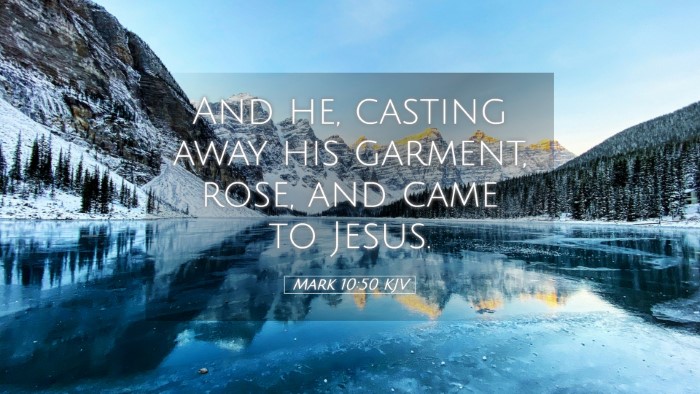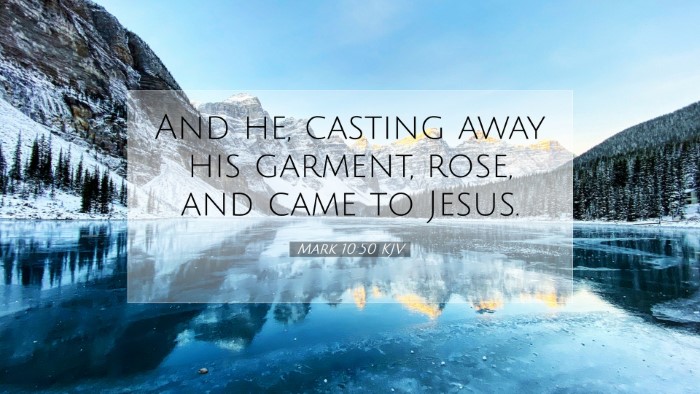Commentary on Mark 10:50
Verse Reference: Mark 10:50 - "And he, casting away his garment, rose, and came to Jesus."
Introduction
The account of Bartimaeus, a blind beggar, presents a rich tapestry of spiritual truths and practical applications for both the believer and the seeker. This commentary draws insights from revered public domain commentaries, namely those of Matthew Henry, Albert Barnes, and Adam Clarke, to explore the depth of this verse.
Contextual Background
In the Gospel of Mark, this episode occurs as Jesus is leaving Jericho on His way to Jerusalem, where He will face the cross. The urgency of Bartimaeus’ cry for mercy amidst the crowd reflects not only his physical blindness but also a spiritual longing for enlightenment and healing in the presence of the Messiah.
Detailed Commentary
1. The Act of Faith
Matthew Henry emphasizes that Bartimaeus’ action of casting away his garment symbolizes a strong act of faith. By shedding his outer cloak, he signifies the abandonment of his former life and social status. This garment was likely a significant part of his identity as a beggar; thus, its removal can be understood as a powerful declaration of his belief in Jesus’ ability to heal him.
2. Desperation Meets Opportunity
Albert Barnes offers insights into the intersection of desperation and opportunity. Bartimaeus’ earnest plea – a cry for mercy – illustrates the essence of humble supplication. When he hears that Jesus is calling for him, he does not hesitate; rather, he rises immediately, highlighting the immediate action that faith compels us to take when we recognize the call of Christ.
3. Urgency in Response
Adam Clarke points out the urgency in Bartimaeus’ response. The phrase "rose, and came to Jesus" captures a moment of immediate obedience. Clarke notes the importance of responding to the Lord’s call without delay, as procrastination can often lead to missed opportunities for spiritual renewal and healing.
4. Symbolism of the Garment
The garment that Bartimaeus cast aside serves multiple symbolic purposes:
- Identity and Social Status: The cloak represents not only his blindness but also the societal perceptions surrounding his worth. By casting it aside, he rejects the stigmas attached to his condition.
- Preparation for Transformation: The act signifies readiness for change. Just as a caterpillar sheds its old skin to emerge as a butterfly, Bartimaeus is prepared to transition from blindness to sight, both literally and spiritually.
- Faith Demonstrated: His decision to leave behind the cloak before experiencing healing exemplifies a profound faith—acting as though the miracle has already occurred.
5. Response to Jesus’ Call
This brief act of Bartimaeus encapsulates an essential truth: the importance of responding to Christ's call. All three commentaries highlight that the act of coming to Jesus involves a personal decision, often requiring the forsaking of prior securities and identities.
Theological Implications
Mark 10:50 is not merely a historical account but a narrative rich with theological implications:
- Faith and Healing: The passage encourages believers regarding the connection between faith and the miraculous work of God. Bartimaeus’ healing demonstrates that faith is often the precursor to divine intervention.
- Call to Discipleship: The act of coming to Jesus reflects the call to discipleship, where followers must leave behind their old selves to embrace a new identity in Christ.
- Hope for the Marginalized: This encounter frames Jesus as a healer for those marginalized by society, reinforcing the message of inclusivity in the Kingdom of God.
Application for Today's Believers
The application of Mark 10:50 extends beyond the historical context and speaks to contemporary believers:
- Casting Away the Old Life: Modern Christians are encouraged to abandon their former ways and identities that do not align with their faith in Christ. This involves a conscious decision to leave behind sin, doubt, and anything that hinders one's relationship with God.
- Responding Promptly to God's Call: The urgency with which Bartimaeus responds serves as a model for believers today. Christians are called to respond quickly and joyfully to God’s prompting in their lives, recognizing the significance of each opportunity to grow closer to Him.
- Embracing Faith Amidst Desperation: Just as Bartimaeus brought his needs before Jesus, believers are reminded to approach God with their concerns, displaying both faith and vulnerability. It teaches us that our needs are valid, and Jesus is ready and willing to listen.
Conclusion
Mark 10:50 provides profound insights into faith, the nature of discipleship, and the transformative power of Jesus. The act of Bartimaeus casting aside his garment symbolizes an essential aspect of the Christian walk—leaving behind the old to embrace the new in Christ. This commentary serves as a guide for pastors, students, and scholars seeking to understand and apply these biblical principles in their lives and ministries.


